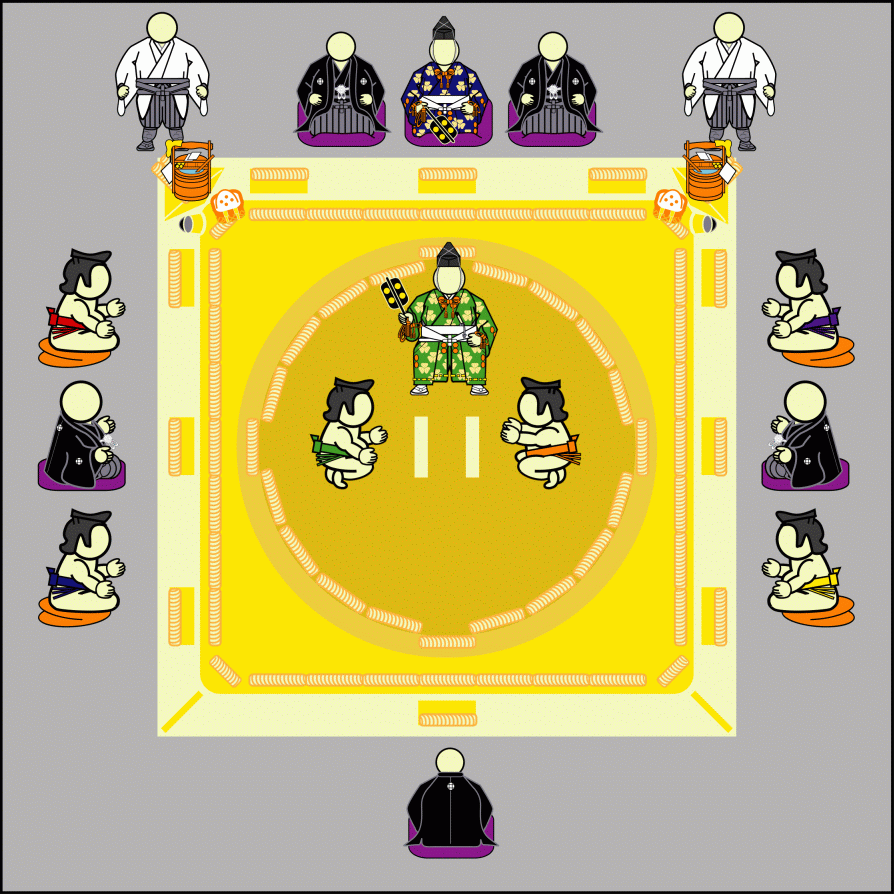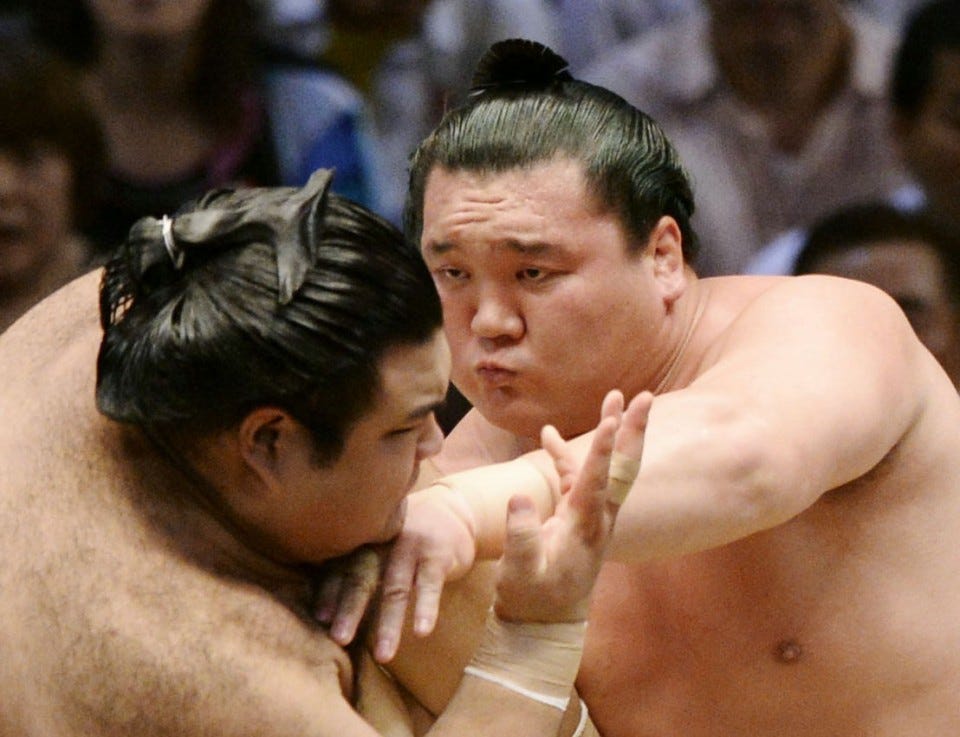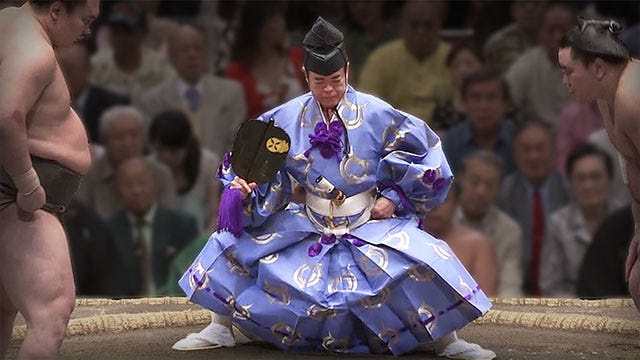A Big Boy's Sumo Primer, Part 2
Learning more things about the wonderful, wild, & exciting world of professional wrestling.
Sumo is, by far, one of the more fascinating sports to be competed in on the planet. In the previous article of this series, the basic history and concept of sumo wrestling was discussed. In this article we’re going to focus less on the specific sport and league concept, and more so take a gander at the pomp and pageantry that are intimately entwined with sumo wrestling.
East vs West
To begin with, let’s discuss something you may notice about sumo. Each competitor enters from one of two entrances and will always enter the arena for their match from that side. This is, in essence, the East vs West division and this division further divides the professional ranks in sumo, with being put into the “East” section of the banzuke considered to be more prestigious. There is no clear answer to why this division exists, and so at this point it can more or less be ignored overall.
Yo, Yobidashi!
As the sumo wrestlers are entering the dohyo, aka the clay arena, for the match you may notice a guy in white shouting and yelling things. These men are called a yobidashi and they are basically the Michael Buffer’s of the sumo world. However, instead of just one guy doing all the work, there are around 44 of them working during the tournament. The yobidashi’s role isn’t limited to just being an announcer, they are also tasked with cleaning the ring, providing the purification salt, building the dohyo, and also displaying advertising banners of companies who are sponsoring a specific match-up that day. Much like the sumo wrestlers and gyoji, yobidashi enter the world of sumo from a young age and eventually work their way up the ranks and become more and more important. They even have their own ring names similar to the rikishi.
Respect the Gyoji
In the very early history of sumo, there were no referees and the person tasked with making a ruling over a match would be the emperor of Japan. Since the 16th century though the gyoji, or referee, has filled that vital role and maintained the rules within a sumo match. They also have probably the best uniform for a job ever.
After the yobidashi announces the rikishi to the ring, the gyoji will also call their names out to summon them onto the dohyo. While the rikish perform their pre-match rituals, the gyoji watches over them and coordinates the initial charge, when the wrestlers tap their fists onto the ground and begin the match. During the match you’ll notice the gyoji starts shouting things at the wrestlers. This is to let the wrestlers know that the match is still going and live. More or less, he is encouraging the wrestlers to keep fighting and to prevent stalling. If the time limit is reached, which is four minutes, he will be signaled by the time keeper and call for the water break and the wrestlers will restart the match from the position they’re in when the water break is called. These sort of breaks also happen if the wrestlers mawashi, garment used to cover their lower body, needs fixing or adjustment. Much like any other combat sport akin to wrestling, the referee is tasked with basically determining the winner under the rules.
The Judges
Not all referee decisions however are final. Sitting around the dohyo are five men dressed in black robes who are all, as it turns out, former wrestlers. They are the shinpan (or sometimes written as shimpan) and they are the judges watching the match.

Much like the rikishi, there is a hiearchy amongst the shinpan and it is based on where they sit around the dohyo. The shinpan order of importance is North, East, South East, South West, and then West. Each day, the shinpan rotate where they sit so that there is equality amongst all five of them. Each position also has different roles as well. For example, the shinpan seated in the South East position acts as the time keeper. There are also video review shinpan in a booth away from the dohyo who have access to instant replay to help review a situation. If a gyoji’s decision is deemed incorrect, which can in itself cause some drama, a shinpan will raise their hand then a mono-ii is called. A mono-ii is simply a discussion that is held by all five judges where they gather in the middle of the dohyo and come to a consensus.
The Rituals
Once the rikishi are summoned to the dohyo for their match they participate in a four minute long ritual that prepares them for their bout.
After mounting the dohyo the rikishi bow to each other and then go to their corner and perform shiko (foot stomps) and receive the chikara mizu and chikara gami. This is where things get kind of becomes mystical, important, and also a fun mini-game while watching a day of sumo (or even a full tournament). The chikara mizu is, translated into English, literally “power water” and the chikara gami means “power paper.”
These items are given by the previous bout competitor to the current bout’s fighters. If we assume there are four wrestlers, A & C are from the east side and B & D are from the west side then the ritual goes as such: if wrestlers A & B fight, and A wins, A sticks around and hands the power water and paper to wrestler C for the C’s bout against wrestler D. In effect, wrestler A is giving wrestler C his power to help them in their match. If a wrestler loses their match, they’re not allowed to hand these items over, only the victorious wrestler may do so.
If two wrestlers from the same side have lost prior to the final bout of the day, then a lower-ranked riskishi will come out and perform the duty of handing the power water and paper. For me, this is sort of all a fun mini-game of “who, or which side, is the best.”
After this stage of the pre-bout ritual is done, the rikishi then grab a handful of salt that is situated in their corner, toss it over the dohyo as a form of purifying the ring and shows that the wrestler is giving themselves up to the mystical powers of the divine. There is an actual fandom that built up around the rikishi Terutsuyoshi for being the most…entertaining in how they throw the salt.
The next step is the series of movements called the chiri-chozu. This is an elaborate way showing that the wrestler is not carrying any hidden weapons. Not that I think they’d be any areas they could easily hide a weapon.
After the chiri-chozu the match then can begin with the face off. The rikish don’t need to take the full four minutes and can have it all done in as quick as one or two.
At the conclusion of the match, the wrestlers return to their respective sides and bow. The loser leaves the arena while the winner squats and makes a motion with their hand. If there is prize money for that specific bout then the gyoji hands it over on a fan and the wrestler takes his stack of money after making a three stroke motion in the air. Then they wait to hand the power water and power paper to the next wrestler from their side of the dohyo and the whole process begins over again.
The Bow Twirling Bit
The end of every day of a sumo tournament concludes with probably one of the funnest bits, the bow twirling ceremony which in Japanese is called the yumitori-shiki.
Usually a riskishi from the makushita division, the highest division in professional sumo, from the winning side of the final bout of the day is handed a traditional bamboo bow that has its draw string missing. The rikishi wears a ceremonial apron that is given to him by the Japan Sumo Association. Though when bouts are held in Osaka, it i given by the Tozai-kai, a group of sumo supporters who attend the matches.
The twirling has a few stages in its ceremony. The first stage of the bow twirling is meant to drive away all evil spirits that are in the air. Next, a digging gesture done with the bow is meant to scare away demons in the ground. The rikishi then performs foot stomps to finish scaring away the evil spirits and demons.
If, for any reason, the bow is dropped the rikishi can’t actually pick it up with his hands as touching the ground signifies defeat. Instead, they have to pick it up with their foot.
And that’s it. That is all the basic info you need to watch sumo though realistically you could probably figure most of it out just by watching a match. While it could be said that the rituals and pageantry stuff isn’t necessary, keeping in mind this sport basically goes back to antiquity its hard to divorce the rituals from the sport. As I mentioned, I find sumo to be one of the most engrossing sports out there and it is a genuine shame it has been squirreled away in Japan and remains a hidden gem waiting to be discovered by a global audience.




